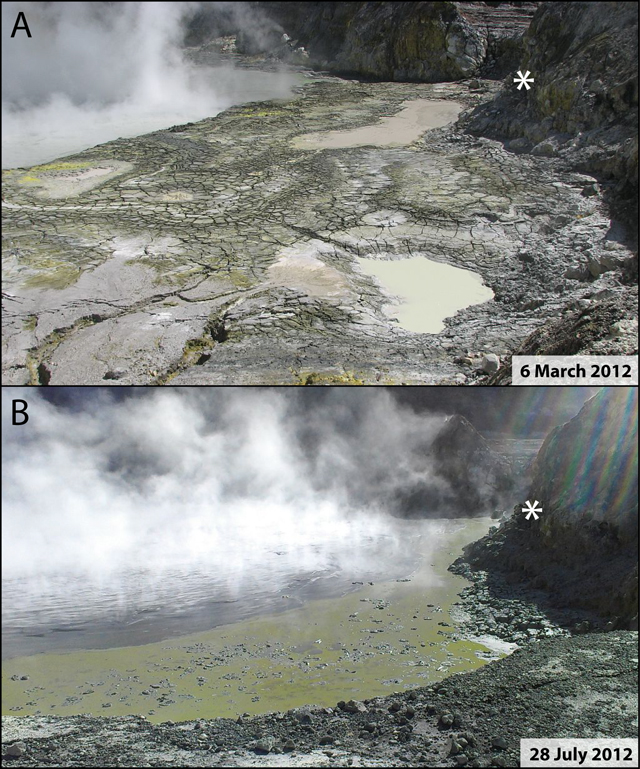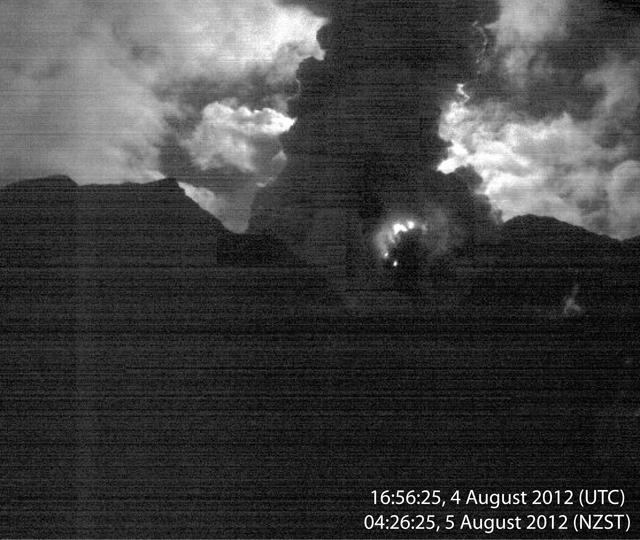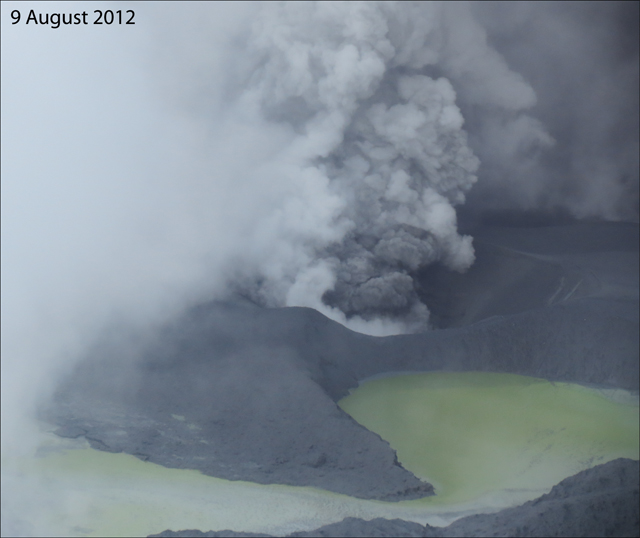Report on Whakaari/White Island (New Zealand) — June 2012
Bulletin of the Global Volcanism Network, vol. 37, no. 6 (June 2012)
Managing Editor: Richard Wunderman.
Edited by Robert Dennen.
Whakaari/White Island (New Zealand) First ash emission in 10 years
Please cite this report as:
Global Volcanism Program, 2012. Report on Whakaari/White Island (New Zealand) (Dennen, R., and Wunderman, R., eds.). Bulletin of the Global Volcanism Network, 37:6. Smithsonian Institution. https://doi.org/10.5479/si.GVP.BGVN201206-241040
Whakaari/White Island
New Zealand
37.52°S, 177.18°E; summit elev. 294 m
All times are local (unless otherwise noted)
After evaporating during 2011 and early 2012, White Island's crater lake rapidly rose on 28 July. Within two weeks, the first ash emissions from White Island in ~10 years occurred. This report summarizes GeoNet Alert Bulletins and provides selected photos of what "may represent the start of a new phase of activity at White Island."
Lake-level rise. During 2011-July 2012, White Island's crater lake slowly evaporated, exposing steam vents and leaving large mud pools on the lake floor (figure 52a). GeoNet reported intermittent volcanic tremor in early July 2012. One period of tremor lasted several hours in the early morning on 28 July; GeoNet stated that it may have been an indication than an eruption had occurred. Later that day, field observations revealed that the lake-level had rapidly risen 3-5 m sometime during the previous night or early morning (figure 52b). According to Brad Scott of GNS Science, rain and water derived from condensation within plumes were the sources of the lake-level rise.
The lake-level rise was accompanied by significant gas-and-steam emissions rising from the water. Gas measurements indicated an increase in SO2 emissions compared to the last measurement three months prior, but CO2 emissions were about the same. Ground surveys indicated that subsidence of the crater floor had stopped, and that the floor may have been slowly rising prior to the lake-level rise. Tremor was more continuous after 28 July 2012. As a result of the increased activity, the Aviation Colour Code was increased to Yellow (on a increasing scale of Green-Yellow-Orange-Red) on 2 August; the Alert Level remained at 1 (on a scale from 0-5).
First ash eruption in more than 10 years. An overnight episode of stronger tremor ended in a volcanic earthquake at 0454 on 5 August. Webcam images during the few minutes following revealed an accompanying plume rising from the crater lake (figure 53). As a result, the Alert Level/Aviation Colour Code was raised to 2/Orange.
Two days later, on 7 August, tremor sharply decreased to levels seen prior to July 2012. A few hours later, however, the plume rising from the crater lake changed color from white to light brown, indicating the first observed ash erupted from White Island since February 2001 (BGVN 26:09). During a visit to the crater area, GeoNet volcanologists confirmed the ash emissions, and photographed the newly formed vent emerging in an area near the SW corner of the 1978/90 Crater Complex (figure 54). They described a 40-50-m-wide tuff cone forming around the vent and isolating the vent from the lake water. Impact craters around the tuff cone were the result of falling ejecta from explosions. The impact craters were confined to the 1978/90 Crater Complex.
Through 13 August, weak volcanic tremor continued, along with steam-and-gas plumes that rose to 200-300 m above the crater and intermittently contained ash. A GeoNet Alert Bulletin released on the afternoon of 13 August announced the lowering of the Aviation Colour Code to Yellow "as a result of generally reduced ash emission." Four days later, on 17 August, the Alert Level was lowered to 1. GeoNet stated that "minor eruptive activity, which is required for Volcanic Alert Level 2, is no longer occurring and the Volcanic Alert Level is consequently reduced from 2 to 1." They noted that little-to-no ash was contained in steam-and-gas plumes, seismicity was low, and typical SO2 levels were emitted during the previous week.
Geological Summary. The uninhabited Whakaari/White Island is the 2 x 2.4 km emergent summit of a 16 x 18 km submarine volcano in the Bay of Plenty about 50 km offshore of North Island. The island consists of two overlapping andesitic-to-dacitic stratovolcanoes. The SE side of the crater is open at sea level, with the recent activity centered about 1 km from the shore close to the rear crater wall. Volckner Rocks, sea stacks that are remnants of a lava dome, lie 5 km NW. Descriptions of volcanism since 1826 have included intermittent moderate phreatic, phreatomagmatic, and Strombolian eruptions; activity there also forms a prominent part of Maori legends. The formation of many new vents during the 19th and 20th centuries caused rapid changes in crater floor topography. Collapse of the crater wall in 1914 produced a debris avalanche that buried buildings and workers at a sulfur-mining project. Explosive activity in December 2019 took place while tourists were present, resulting in many fatalities. The official government name Whakaari/White Island is a combination of the full Maori name of Te Puia o Whakaari ("The Dramatic Volcano") and White Island (referencing the constant steam plume) given by Captain James Cook in 1769.
Information Contacts: GeoNet, a collaboration between the Earthquake Commission and GNS Science (URL: http://www.geonet.org.nz/); Brad Scott, GNS Science, Wairakei Research Center, Private Bag 2000, Taupo 3352, New Zealand (URL: http://www.gns.cri.nz/); Earthquake Commission (EQC), PO Box 790, Wellington, New Zealand (URL: http://www.eqc.govt.nz/).




